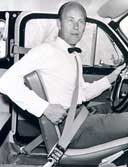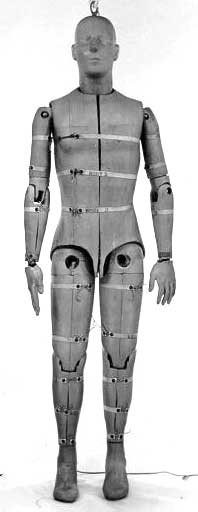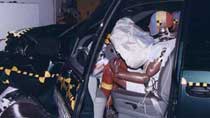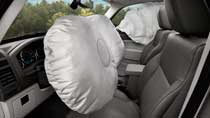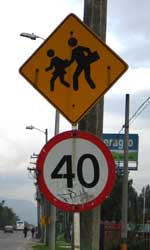Staying Safe on the Road Safety Standards and Equipment
The Seat Belt
|
|
Photo courtesy of Volvo Car Corporate—Sweden Engineer Nils Bohlin, who worked for Volvo Cars of Sweden, developed the three-point harness seat belt in 1958. Although Volvo began using this invention right away, auto makers around the world did not routinely install this type of seat belt until the 1970s. |
The original seat belt was a lap belt that buckled in the center. It held a person’s lower body in place during a collision. However, the center buckle often caused severe internal injuries, as the upper body moved forward and down into the dashboard or steering column. In 1958, Nils Bohlin, an engineer with Swedish automobile manufacturer Volvo, invented the three-point harness, which straps across the lap and chest, keeping the upper body stable in a collision. This type of seat belt quickly became the standard in Volvos, first for the front seats and later for the backseats as well. However, the three-point harness did not become standard front-seat equipment throughout the world until the 1970s; it wasn’t until the 1990s that all other seats also included this type of seat belt.
The Evolution of Safety Standards and Equipment
The era of modern safety standards began in 1958, when the United Nations established a World Forum for Harmonization of Vehicle Regulations. An agency of the United Nations Economic Commission for Europe (UNECE), this body created a set of international standards for vehicle safety. In general, these codes cover lighting, instrumentation, braking, restraint systems, and the car’s capacity to protect its occupants. Many nationas now adhere to these codes, including the European countries, Russia, Japan, South Korea, and Malaysia. The United States and Canada have adopted similar codes, although there are differences concerning headlights. Countries that have not subscribed to the UNECE standards include all the African and South American countries, most Southeast Asian countries, China, and India.
|
Sierra Sam was the prototype of the crash test dummy, although it was not used in automobile tests. |
Safety equipment is now mandatory for all vehicles. Much of the equipment and many of the safety standards were developed by automobile manufacturers in Europe. However, the evolution of auto safety equipment can most easily be traced in the United States, because it was long the largest automaker in the world.
In the United States, the movement toward safety regulation was given impetus by the consumer advocate and attorney Ralph Nader. In 1965 Nader published a book about the U.S. auto industry called Unsafe at Any Speed. In this book he made a particular example of General Motors’ Chevrolet Corvair, a car whose poor handling capabilities were said to cause spinouts and rollovers. His larger point, however, was that the industry was generally unwilling to spend money on safety improvements even when the dangers were known. The book came out at a time when there was a very high number of automobile fatalities in the United States: 50,000 deaths each year, even though there were far fewer cars on the road than there are today.
Nader’s efforts helped galvanize the U.S. Congress into action. In 1966 it passed a law creating various agencies that were eventually consolidated into the National Highway Traffic Safety Administration (NHTSA). One of these agencies mandated the installation of lap belts for all seats in 1966 and of shoulder belts for front seats in 1968. The NHTSA soon required that cars sold in the United States also include features such as headrests (to prevent whiplash), collapsible and energy-absorbing steering wheels (to prevent the driver from being severely injured in a collision), and shatter-resistant windshields. Later came the addition of high-mounted rear brake lights, for better visibility, and front and side air bags that inflate automatically in the event of a collision.
The most recent significant safety advance, soon to be mandatory in the United States and Europe, is electronic stability control (ESC). This computerized technology improves vehicle handling by detecting and preventing skids. When ESC detects loss of steering control, it automatically applies brakes to individual wheels to help steer the vehicle where the driver wants to go. It incorporates the antilock-brake and traction-control systems that have been available on most new cars for some years, but it takes the control a step further.
Since 1979 the NHTSA has also tested the safety of new car models. Its program tests and rates the cars on the basis of how well the vehicle’s occupants will fare in the event of a collision or a rollover and how likely the vehicle is to roll over. The NHTSA, the U.S. motor vehicle manufacturers themselves, and other organizations that conduct such tests all use standardized crash dummies. These are designed to mimic human physiology and thus to indicate the extent of injuries to the head, chest, and other parts of the body. Crash dummies have been around since 1949, when a U.S. engineering company created one called Sierra Sam. All the major car-manufacturing countries now have such testing facilities.
|
Automobile makers use crash test dummies to test the protection automobiles provide for drivers and passengers during collisions. The modern crash test dummy realistically mimics the point of motion of the human body, and may even include sensors to indicate the impact on the body. |
Airbags located in the steering wheel and dashboard inflate during a head-on collision, protecting the front-seat passengers from extensive injury. Side curtain airbags over the windows keep broken glass and debris from coming in and keep occupants from hitting the windows. |
Crash tests have resulted in major improvements not only to air bags and such elements but also to the actual structure of the car. For example, earlier automobiles were very stiff. Newer models incorporate crumple zones, which absorb the energy of the collision, resulting in less energy that could crumple the passenger compartment. This actually helps protect the occupants of the car because it reduces the shock of the impact on their bodies.
Motorcycles are also crash-tested using dummies. The tests, which usually simulate crashes between motorcycles and cars, have led to the development of protective devices for these vehicles as well. These include crash bars or roll bars, which help protect the rider’s legs in the event of a rollover or glancing collision. Air bag systems have also been developed. One type, though, is incorporated into the rider’s jacket. In fact, much of the safety equipment for motorcycles comes in the form of the protective gear that the rider should wear.
|
|
|
|
|
Photos courtesy of Juan Esteban Revelo Hinestroza Road signs alert drivers to a change in the road conditions, whether it is a curve in the road (left), a different speed limit, or the possible presence of pedestrians (right). |
||
The NHTSA and equivalent organizations in other countries have also turned their attention to factors of road safety. These include making sure that busy streets have lighting, marking curves in the road with stripes and reflectors along the road edge, adding reflective stripes to indicate safe and unsafe passing areas, using barriers to divide opposing lanes of traffic, and putting guardrails at the edges of roads. Newer road-safety innovations include rumble strips along the edge or in the center of highways. These grooved sections cause a vehicle to vibrate very noisily if a sleepy or otherwise inattentive driver starts to drift off the road or over the center line.
|
|
|
 |
Digging DeeperFind out more about |
|
|
|
This content has been re-published with permission from SEED. Copyright © 2024 Schlumberger Excellence in Education Development (SEED), Inc.


